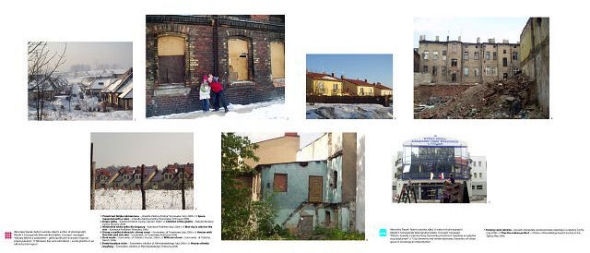
Description popularizing the research project
In the story about the Little Match-Seller the world is cold, sad and depressing. Flickers of hope quickly die down there. Gray days keep passing by. Today is just like yesterday and nobody even thinks of tomorrow as it will not be any better. In the fairy tale about the Sleeping Beauty the world is prosperous, full of warmth and light. Hope is unnecessary because it is replaced with high self-esteem, satisfaction and certainty that the next days will be good as well.
The two stories are being told here and now but it is not easy to find them. No road signs show the way. But when you leave the main streets, slow down a bit and enter post-industrial districts of Silesian cities you will find them. A visionary patron could create an open-air museum there, full of gems of industrial architecture. It is a world of fallen industries. Time stopped there for people who signed pacts with steelworks, coal mines or factory. Their lives lie in ruins just like the houses they live in. If you go in the opposite direction - to suburbs you will find the other story. You will see colorful houses with sloping roofs, gardens, patios and garages. Cars are gleaming on the drives, electronic eyes of wrought-iron gates twinkle like stars and high-heel shoes clack on the patterned marble floor.
These are different worlds. Both are inaccessible. The luxurious one is guarded with vigilant eyes of closed-circuit television, high fences, gates and security guards. The other one defends itself with a proud look in the eyes and a non-verbal message saying: 'Don't even look at us. Don't need your compassion'. Not many try to understand the worlds which do not meet each other. The question is why they do not meet. Are they unwilling or unable to do it? The plots of the 'fairy tales' will probably never meet as internal and external isolation created barriers which are hard to cross. Are they ghettos? For most of us, who do not seek ways to the economic and mental enclaves, they are real ghettos.
But is it enough for a moral of the story?
Abstract
The main goal of this project was describing two types of ghettos: social and spatial, located in a traditional industrial region, of Upper Silesia. The first of them are ghettos of poverty. Their origin is a result of degradation of city quarters located near big industrial plants. The second type, which is not very common in Silesia region yet, ghettos of wealth, have their roots in the transformation processes. Even though rarely they can be described as typical gated communities, for sure they can be identified as such by place of good ecological conditions, higher economical status of its inhabitants and also a higher level of education and aspirations which means a place where nascent middle class lives.
Well planned estates of colorful houses, resembling buildings of the Lego bricks, with the streets named after cartoon characters or other pop culture icons. These estates of prosperity more and more frequently, very clearly separate themselves from the city space. Located in areas which are attractive from an ecological point of view, are fenced off with clearly marked borders. These borders have here double meaning. Not only literal (wall, fence, gate) but also a metaphorical one - social borders, which divide citizens into the rich - the present and the poor - the absent. The borders create two societies: "luxurious and normal" and "poor and pathological".
We define a ghetto as an area which is characterized by the following:
- Clearly spatial separateness - even when there are no well-defined physical borders (wall, fence, gate) we can show limes in the area or mental maps, which claim that the described area is different,
- equal status of inhabitants,
- relatively homogenous buildings,
- feeling of separateness (social, mental),
- feeling of exclusion,
- low penetration between the area of a ghetto and the rest of the city
In our project we analyzed 250 digital photos taken in Tychy, Katowice, Świetochłowice and Sosnowiec in January / Febraury 2006. We were trying to answer the following questions: how the ghettos in cities of Silesian voievodship look like? Who the main actors in the process of ghettoization are, how their daily life goes on? The most important result was a portray and characteristics we made of the process of ghettoization in the old industrial region, and also paying attention to the reasons and results of ghettos in our region.

